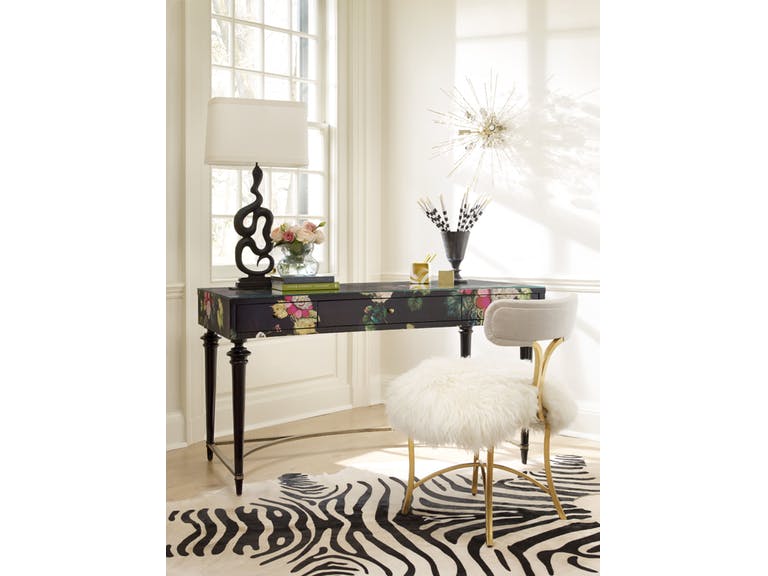
You just gotta love the floral embellishments on this Cynthia Rowley for Hooker Furniture Home Office Fleur de Glee Writing Desk.
Decorative painting can easily turn any living space into a real beauty. When you have ample time to take on this project as a do-it-yourself task, then do so. It may not be easy but it can be fun and truly rewarding.
Decorative painting is both a representational as well as a non-representational painting on any architectural element. This can also be any article of applied art.
Primarily, decorative painting is crucial in many architectural projects. It is often used to embellish interior and exterior parts of many structures. It can either hide architectonics or it can accentuate a lovely part. Decorative paintings are often applied directly to the ceilings or walls.
Commonly used media are tempera, fresco, glue paints, and oil paints (in some cases). Silicate paints became popular in the late part of the 19th century.
Decorative Painting on Textiles
Another kind of decorative painting is textile embellishment. In folk arts, decorative painting is often seen as an independent local art branch. Decorative painters come up with their own artistic expressions, often, in their attempt to imitate others. These artists often develop amazing techniques and go through intensive labors.
Decorative painting is an art form that is diverse that it makes use of different techniques and media in order to decorate spaces or beautify even a non-functional surface.
Since the development of the most sophisticated and systematic methods of decorative painting, many have tried this kind of art. The freehand designs, as well as the patterns, now allow a higher amount of success even without formal or academic training.
Even those without drawing abilities are now enticed to become creative and crafts-loving people. Those who embrace contemporary art learn that there is a myriad of decorative painting options. There are also those that infuse the styles of the past into their contemporary work. These are the ones that present the pieces that can easily become a heritage to the next generations.
Tole Painting
Tole painting is the term commonly used in describing decorative painting that’s applied to surfaces made of tin. People from New England are most familiar with the term.
Contemporary decorative painting is seen in folk arts in Norway, Sweden, Russia, Germany, Mexico, and England. Stenciling, bronzing, faux finishing, country painting, gold leafing, graining, and theorem are all facets of the Early American type of decorative painting.
Tole painting can be learned by anyone who is willing to put a little time and effort in practicing some techniques. You don’t have to be a master of color schemes or drawing. There are actually a lot of designers all over the world who have come up with their own tole paintings in books and homes.
You can begin by adding basic designs on the level of a beginner.
Sponge Painting
The fun part of decorative painting is wanting to surround yourself with color and other decorative elements. Buy a painted chair, paint an old candelabrum, decorate your own tissue box, or simply treat a blank wall as your canvas and you’re already on the path to adding visual punch to your home.
Sponge painting is a quick way to provide a subtle texture as well as depth onto your walls. Don’t worry about messing up because it is easy to fix less-than-perfect spots.
You will need the following –
Semi-gloss or high-sheen paint
Clear latex glaze
Paper plates
Two natural sponges
Two paint buckets
Stir stick
Cardboard
Sponge roller or Trim brush
Newspaper
Procedure
Base coat a dry wall using your paint roller. Let dry before applying the second coat. Allow to dry then use painter’s tape to mask the areas around windows, doors, the floor, and the ceiling.
Mix one part of high-gloss paint with four parts of clear latex glaze. Fill the second bucket with water (about half full). The second bucket will be used for sponge rinsing. As for the paint mixture, use the paper plate as your palette.
Dampen the sponge, wring thoroughly, and then dip into the paint mixture. Blot onto the newspaper then apply the sponging technique to your walls.
© McCreery's Home Furnishings | All Rights Reserved | Privacy Policy